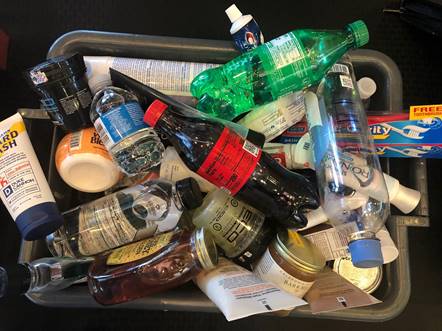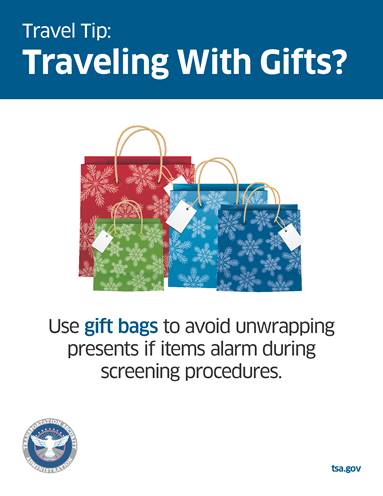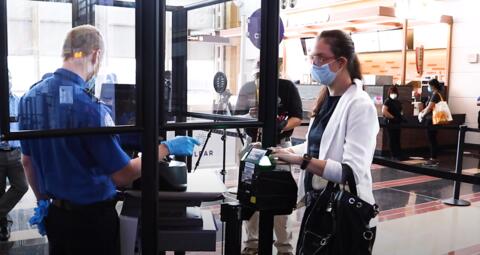The Transportation Security Administration (TSA) is prepared for holiday travelers who are planning to fly out of Newark Liberty International, JFK International and LaGuardia Airports during the Christmas and New Year holidays as passenger volume is expected to increase during the end-of-year travel period.
“TSA is committed to supporting a healthy and secure environment for airline passengers, TSA employees and airport personnel throughout the holiday season and into the new year,” said Thomas Carter, TSA’s Federal Security Director for New Jersey.
“I have three recommendations for travelers at this time of year. Get to the airport early. Wear a mask. And know before you go—meaning know what is in your carry-on bag so that you don’t have any prohibited items that will likely trigger an alarm.”
Tip #1: Get to the airport early
Travelers who are ticketed to fly out of Terminals A and B at Newark Liberty International Airport should arrive a minimum of two hours before their scheduled domestic flights and three hours before scheduled international flights.
This is necessary as security checkpoint operations have changed due to the closure of one-third of the checkpoint lanes in Terminal A due to the ongoing modernization and redevelopment of the new Terminal A.
The project is in its final phase of construction, which includes the closure of all four checkpoint lanes in the A1 concourse.
As a result, there are higher than usual wait times during peak periods at the remaining available checkpoint lanes in concourses A2 and A3, which have four checkpoint lanes each.
Additionally, several flights are being shifted to Terminal B, which is also impacted because many flights that usually depart from the A1 concourse are being moved to Terminal B.
Travelers are advised to check with their airlines often to confirm the terminal and concourse of their flight departure due to the fluid situation of ongoing construction.
Tip #2: Wear a mask
Travelers, TSA personnel and other individuals who work in the airports are required to continue to wear a mask as prescribed by the federal mask mandate when they are in airports, bus, and rail stations, as well as while on passenger aircraft, public transportation, passenger railroads, and buses on scheduled fixed-routes.
This means that all travelers must be wearing a mask at TSA airport screening checkpoints and throughout the airport and during their flights.
If a traveler does not have a mask, a TSA officer will offer a mask to that individual at the checkpoint.
Tip #3: Know before you go
Travelers need to know what can and cannot go in their carry-on bag, from firearms to oversize liquids.
Passengers will spend more time in the security checkpoint if their carry-on items trigger an alarm because it results in TSA’s need to resolve the alarm by opening the carry-on bag to determine what triggered the alarm.
“During a pandemic, it is important to try to reduce touch points, so now more than ever, it is important to know what should not be packed among your carry-on items,” Carter said.
“Advance planning and packing properly will facilitate the screening process and ease your travel experience at the airport.”
The most common items that travelers bring to the checkpoint that are not permitted through the screening process are liquids, gels, and aerosols larger than the acceptable limit.
Each passenger may carry liquids, gels and aerosols that are 3.4 ounces (100 ml) or smaller through a checkpoint as long as those items fit into a one quart-sized, resealable bag. This is known as the 3-1-1 bag.
Common travel items that must comply with the liquids rule include toothpaste, shampoo, conditioner, sunblock, body spray, mouthwash and lotions.
Containers of liquids, gels, and aerosols larger than 3.4 ounces (100 ml), regardless of the size container, can be transported in checked baggage.

TSA officers also see travelers arrive at the checkpoint with bottles of water, juice, energy drinks, coffee and soda.
TSA officers will give travelers a choice to exit the security checkpoint to drink their beverages in the terminal or allow the officer to dispose of it.
Travelers may bring empty containers such as a water bottle or insulated bottle through checkpoints and fill them on the secure side of the checkpoint.
The exception to the 3-1-1 rule is that due to the pandemic, TSA is now allowing travelers to bring one liquid hand sanitizer container up to 12 ounces per passenger in carry-on bags until further notice.
Passengers can expect that these containers larger than the standard allowance of 3.4 ounces of liquids permitted through a checkpoint will need to be screened separately, which will add some time to their checkpoint experience.
TSA offers several ways for travelers to find out if an item is permitted in a carry-on bag, checked bag, either or neither.
The TSA website has a feature on the homepage called “What can I bring?” Type in the name of the item, and it will let you know if it should be packed in a checked bag or carry-on bag. The same handy feature is available on the free downloadable MyTSA app.
The MyTSA app gives users 24/7 access to the most frequently requested airport security information on any mobile device, including a searchable database that will let you know whether an item can be packed in a carry-on bag, checked bag, either or neither.
The app also identifies delay information and current weather conditions at your favorite airports nationwide.
TSA is also active on social media. Travelers can send a question via Twitter to @AskTSA or via Facebook Messenger for live assistance in answering your questions from 8 a.m. to 6 p.m. ET weekdays; 9 a.m. to 6 p.m. on weekends and holidays.
This also is the time of year that passengers frequently travel with gifts.
TSA recommends packing gifts in gift bags or gift boxes instead of wrapping them because if a gift triggers an alarm, it will need to be opened to resolve the alarm.
Wrapped gifts that trigger an alarm will need the gift wrap removed, but if the gift is in a bag or a box, it is simple to look at the item to resolve the alarm.

Individuals also like to travel with food items during the holiday season. Foods may be transported on flights.
What’s important to know is whether the food item can be packed in a carry-on or checked bag. Solid food items like fruitcakes, candy canes and chocolates are solids and may be transported in a carry-on bag.
However, liquids and spreadable foods such as egg nog, wine, champagne, maple syrup and preserves are not solid and should be packed in checked bags.
Individuals with disabilities, medical conditions and other special circumstances can contact the TSA Cares Helpline for additional assistance during the security screening process and to find out what to expect at the checkpoint.
Individuals may request assistance through the TSA screening checkpoint by clicking here or by calling (855) 787-2227 (Federal Relay: 711) 72 hours before traveling with questions about screening policies, procedures and what to expect at the security checkpoint.
The TSA Cares phone lines are staffed weekdays from 8 a.m. to 11 p.m. ET and on weekends/holidays from 9 a.m. to 8 p.m. ET.
TSA staff can explain the screening process for travelers requiring special accommodations or concerned about the security screening process.
Individuals who are planning to travel this Christmas season or next year should consider enrolling in TSA PreCheck®.
The popular expedited screening program allows travelers to leave on their shoes, jackets, belts and enables them to keep their electronics and 3-1-1 bags in their carry-on bags.
TSA PreCheck membership is more valuable now than ever before because it reduces touchpoints during the pandemic and puts travelers in security lines that have fewer travelers and move quicker, which encourages social distancing.
